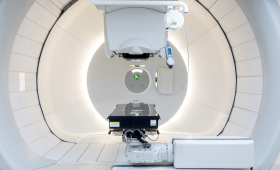3.0T nuclear magnetic resonance
1. What is MRI?
Nuclear magnetic resonance (NMR) is a physical process in which a nucleus with a non-zero magnetic moment has a Zeeman split in its spin level under the action of an external magnetic field, and resonance absorbs a certain frequency of RF radiation. Nuclear magnetic resonance spectroscopy is a branch of spectroscopy in which the resonance frequency is in the radio frequency band and the corresponding transition is the transition of the nuclear spin at the nuclear Zeeman level.
Magnetic resonance imaging (MRI) examination has become a common imaging examination method, MRI as a new imaging examination technology, will not have an impact on human health, but six groups of people are not suitable for MRI examination: People with cardiac pacemakers, people with or suspected metal foreign bodies in the eyeball, people with aneurysm silver clip ligation, people with body contents or metal prostheses, critically ill patients with life-threatening conditions, patients with claustrophobia, etc. Monitoring equipment, rescue equipment, etc. cannot be brought into the MRI examination room. In addition, pregnant women less than 3 months pregnant, it is best not to do MRI.
2. Advantages and disadvantages of MRI
1, advantages: no ionizing radiation damage, non-invasive to the human body, multi-directional and multi-parameter imaging, can show the relationship between anatomical structure and pathological structure, in addition to showing morphological changes, can also be functional imaging and biochemical metabolism analysis;
2, disadvantages: many contraindications, such as the body with a pacemaker or a ferromagnetic substance in the body can not be examined, the need for monitoring equipment can not be MRI examination. The display of calcification and bone is not as good as CT, and conventional scans are long, noisy, and expensive.
3. Application of nuclear magnetic resonance
1. Lesions were found
Nuclear magnetic resonance imaging is a new medical imaging technology using the principle of nuclear magnetic resonance, which has excellent diagnostic function for the brain, thyroid, liver, gallbladder, spleen, kidney, pancreas, adrenal gland, uterus, ovary, prostate and other parenchymal organs, as well as the heart and large blood vessels. Compared with other auxiliary examination methods, MRI has the advantages of multiple imaging parameters, fast scanning speed, high tissue resolution and clearer images, which can help doctors "see" early lesions that are not easily detected, and has become a sharp tool for early screening of tumors, heart disease and cerebrovascular diseases.
It is understood that because the metal will interfere with the external magnetic field, the patient must remove all the metal objects from the body before the MRI examination. Magnetic objects such as watches, metal necklaces, dentures, metal buttons, and contraceptive rings should not be worn for MRI examination. In addition, wearing a pacemaker and having paramagnetic metal implants in the body, such as metal clips, stents, plates and screws, cannot be examined by magnetic resonance imaging. The upper abdomen (such as liver, pancreas, kidney, adrenal gland, etc.) magnetic resonance examination must be empty, but you can drink enough water before the examination, which is conducive to the clearer boundary between the stomach and the liver and the spleen.
2. Tumor was found
Mri is the most effective imaging diagnosis method for brain and spinal cord diseases, which can not only detect tumor, cerebral infarction, cerebral hemorrhage, cerebral abscess, cerebral cysticercosis and congenital cerebrovascular malformation in the early stage, but also determine the types and causes of hydrocephalus. For the first major gynecological disease that endangers the life and health of Chinese women - breast cancer, MRI precision screening can help find early breast cancer lesions; For the "hypertension, hyperlipidemia, hyperglycemia" and other three high people, you can through the head and heart and other parts of the nuclear magnetic examination, before the physical health has not issued a red light alarm, early detection of heart disease, brain infarction and other high-risk diseases hidden dangers. In addition, MRI can also carry out abdominal and pelvic examination, such as liver, gallbladder, pancreas, uterus, etc., can be examined, and abdominal great blood vessels and limbs vascular imaging can clearly diagnose true and false aneurysms, dissecting aneurysms and various lesions of limbs blood vessels. Mri is very sensitive to aseptic necrosis of bone marrow and bone in the diagnosis of various joint tissue lesions.
3, harmless to people
Because MRI is magnetic field imaging, there is no radioactivity, so it is harmless to the human body and is very safe.
4. Main functions of 3.0T magnetic resonance equipment
It can be used to study the brain cognition and structure of all kinds of people. Cognitive psychology; Structure, function and metabolism in brain diseases. Specific research interests include: functional brain imaging fMRI(BOLD, resting state, CBF, CBV); Body structure imaging (3D, DTI MRA); Magnetic resonance spectroscopy (in-vivo MRS); Material magnetic resonance imaging, such as contrast agent T 1, T 2 quantitative measurement.
Related videos
-
 Can Traditional Chinese Medicine Treat Lung Cancer: Saving or Killing Lives
Can Traditional Chinese Medicine Treat Lung Cancer: Saving or Killing Lives一洲在线
-
 Many of these four types of cancer can survive for a long time
Many of these four types of cancer can survive for a long time健康在线
Recommended Reading
-

Great Lecture Hall | Development and Trends in Cancer Therapy
2023-09-01 08:14:00 -

Happy birthday in the ward, let the children smile more brightly
2023-08-29 14:10:55 -

Post flood reconstruction in Zhuozhou, Yizhou Cancer Hospital in action
2023-08-29 11:59:27 -
Our hospital has organized post disaster free clinics in communities such as Shui'an Flower City in Zhuozhou City
2023-08-26 11:42:37




